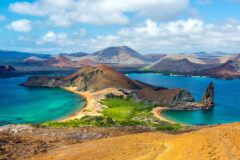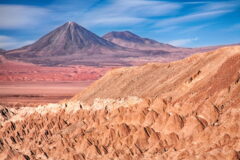When to go to the Atacama Desert
Perched in northern Chile between the Pacific Ocean and the soaring Andes Mountains, the Atacama Desert stretches across an arid region of extraordinary beauty. As the world's driest desert, this barren landscape of moon-like valleys, turquoise lagoons and sprawling salt flats draws travellers year-round. But choosing the best time to visit Atacama can transform your experience from good to unforgettable.
From the ethereal salt flats of Salar de Atacama to the otherworldly terrain of Valle de la Luna, Chile's Atacama Desert offers dramatic scenery that shifts with the seasons. Clear skies make it a paradise for stargazing, while daytime temperatures remain surprisingly pleasant thanks to the high altitude. The oasis town of San Pedro de Atacama serves as the gateway to this remarkable region, where each season brings its own character to the desert floor.
Understanding Atacama's seasons
The Atacama Desert enjoys a unique climate where rain is almost non-existent. This extreme aridity creates stable conditions year-round, though subtle seasonal variations affect everything from flamingo gatherings to stargazing conditions. Here's what to expect throughout the year.
Best time to visit by interest
For stargazing and astronomy
The Atacama Desert's clear skies and high altitude create some of Earth's finest conditions for observing the night sky. Winter months (June to August) offer the sharpest celestial views, when dry air and longer nights combine with minimal atmospheric disturbance. Major astronomical observatories dot the region precisely because of these conditions. Time your visit during a new moon phase, as the absence of moonlight offers the best viewing.
For wildlife and flamingos
Summer (December to February) is peak season for spotting the three flamingo species that inhabit the salt flats. Large flocks gather at Chaxa Lagoon and other wetlands, creating incredible viewing opportunities. The rare James's flamingo joins more common Chilean and Andean flamingos during these months. Beyond flamingos, you might spot vicuñas, Andean foxes and various bird species year-round, though wildlife is most active during the cooler hours of summer days.
For photography
Shoulder seasons (March to May and September to November) provide ideal photography conditions. The sun sits lower in the sky than during summer, creating dramatic shadows across Valle de la Luna and other rock formations. Fewer tourists mean you won't be jostling for position at popular viewpoints. The striking contrast between the barren landscape and occasional clouds adds depth to your images. For astrophotography, winter remains unmatched.
For adventure activities
Spring and autumn offer the most comfortable temperatures for physical activities. Whether cycling through Valle de la Muerte, hiking to high-altitude lagoons, or climbing desert peaks, these seasons strike the perfect balance. Days are warm enough to be pleasant but not so hot that exertion becomes uncomfortable. The high altitude affects everyone differently, so the moderate temperatures of shoulder seasons allow better acclimatisation.
Summer (December - February)
During the summer months, the Atacama Desert comes alive with visitors drawn by warm, sunny days and pleasantly mild nights. Daytime temperatures hover around 18-20°C, perfect for exploring Moon Valley or cycling to the Devil’s Throat. The clear skies are exceptional for stargazing, with the Milky Way often stretching brilliantly overhead.
This is peak season for wildlife enthusiasts. Wild flamingos, including the rare James’s flamingo, gather in spectacular numbers across the salt flats at Chaxa Lagoon and Laguna Cejar. Against the backdrop of snow-sprinkled peaks and the desert’s russet tones, these gatherings create amazing photo opportunities.
However, summer brings a caveat. January occasionally sees bursts of rainfall, part of the phenomenon known as the Altiplanic Winter, which occurs between December and March. This means it can restrict access to some salt flat excursions. While the Atacama remains the driest desert on Earth, these rare downpours remind visitors that nature keeps its own schedule. Early morning trips to El Tatio Geysers are particularly magical in summer, when the geysers’ steam columns are most dramatic in the cool dawn air.
Average max daytime temperature: 18°C
Average min nighttime temperature: 6°C
Rainfall: 12 days per season
18°C Average max daytime temperature
6°C Average min nighttime temperature
12 days per season rainfall
None humidity

Autumn (March - May)
As peak season ebbs, autumn emerges as one of the best times to visit the Atacama Desert. Temperatures drop slightly but remain pleasantly warm by day, while cool nights make stargazing particularly rewarding. The thinning crowds mean you’ll have popular attractions like the hissing geysers largely to yourself.
This shoulder season offers excellent value and flexibility. The atmospheric conditions remain superb for visiting astronomical observatories, where the dry air and minimal light pollution reveal celestial wonders invisible elsewhere in Latin America.
March is particularly appealing, as the Altiplanic Winter has passed but daytime warmth lingers. It’s ideal for active pursuits such as hiking through lunar-like landscapes, mountain biking across the jagged terrain, or horse riding to ancient fortresses. The stark contrast between warm days and crisp nights epitomises the desert experience.
Average max daytime temperature: 16°C
Average min nighttime temperature: 2°C
Rainfall: 4 days per season
16°C Average max daytime temperature
2°C Average min nighttime temperature
4 days per season rainfall
None humidity

June- August
Winter (June – August)
The winter months bring shorter days and a different character to Chile’s Atacama Desert. While daytime temperatures remain comfortable at around 13°C, nights regularly plunge below freezing. July can bring snowfall to higher elevations, dusting the Andes peaks in white and creating dramatic vistas across the arid landscape.
Despite the cold nights, winter offers unique rewards. The night sky reaches peak brilliance between June and August, when astronomical conditions are at their best. Many visitors time their trips specifically for these months to experience exceptional stargazing. Pack plenty of layers – thermal clothing, fleeces, and warm jackets are essential for evening excursions and dawn visits to El Tatio Geysers, where temperatures can be arctic.
An unexpected wonder occasionally follows winter rainfall. If you’re lucky, you might catch endemic wildflowers blooming across the plains in a brief explosion of colour. This rare desert flowering transforms the barren landscape, though timing is unpredictable and depends on sufficient precipitation.
Average max daytime temperature: 13°C
Average min nighttime temperature: -2°C
Rainfall: Minimal
13°C Average max daytime temperature
-2°C Average min nighttime temperature
0 days per season rainfall
None humidity

Spring (September - November)
Spring rivals autumn as an ideal time to visit the Atacama Desert. As temperatures warm and days lengthen, the desert awakens from winter’s chill. With fewer crowds than summer but better weather than winter, spring offers the sweet spot many travellers are looking for.
This is prime time for adventure activities. Horse riding across the landscapes of Valle de la Luna takes on a special quality in the crisp spring air. Hiking trails that were too cold in winter become accessible again, while the heat of summer hasn’t yet arrived. The atmospheric clarity remains excellent for photography, with the low-angle spring sun casting dramatic shadows across rock formations.
Spring also coincides with various Andean festivals in small towns around the region, offering glimpses into local culture. The night sky continues to dazzle, though not quite with the intensity of winter’s astral display.
Average max daytime temperature: 17°C
Average min nighttime temperature: 2°C
Rainfall: 3 days per season
17°C Average max daytime temperature
2°C Average min nighttime temperature
3 days per season rainfall
None humidity

Papagaio
Your edit for Latin American inspiration
Our exciting range of articles on Latin America explore everything from iconic destinations and lesser-known cultural gems to delicious traditional recipes. You’ll also find exclusive travel tips, first-hand client reviews and the chance to get your personal questions answered by our travel experts.
View Extraordinary Inspiration




































